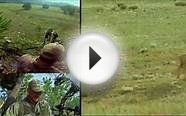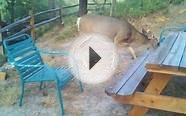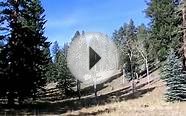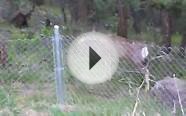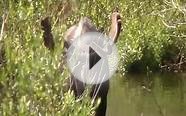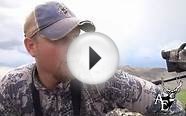Deer in Colorado
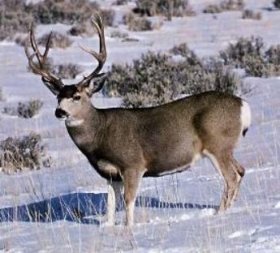
Deer Facts
Description: There are two species of deer in Colorado
- Mule deer – with their rope-like tails, evenly forked antlers and extravagant ears. Mule deer bound with stiff-legged gait, the tail held down
- White-tails – with smaller ears, antlers with a single main beam bearing smaller tines, and, of course, broad white tails. White-tails move with a graceful lope, the flag-like tail held erect.
Both species of deer are four to six feet long and stand three feet or more high at the shoulder. Weights of large bucks range over 400 pounds, but does are only half that size. Adult males begin to grow antlers in spring, used in a clash for dominance and breeding rights in autumn. Antlers are then shed in winter.
Range: Mule deer are abundant statewide. White-tails have become increasingly common in streamside woodland and nearby crop lands along the rivers of the eastern plains. There are no White-tail deer in La Plata County.
Habitat: Mule deer occupy any "edge" habitat, including suburban residential areas.
Diet: Deer are browsers, feeding mostly on woody vegetation, including twigs and leaves of shrubs and trees, including ornamentals. They also forage on crops, especially corn. Because they eat little grass, they tend not to compete seriously with livestock or elk.
Reproduction: Deer breed from October to December. After a gestation period of six and a half months, spotted young (usually twins) are born. Deer are frequent traffic casualties, and mountain lions, coyotes and packs of feral dogs prey upon them. Licensed hunters take 50, 000 to 80, 000 deer annually in the state from a population estimated at 700, 000 animals statewide.
Description: The wapiti, or elk, is the largest of Colorado’s native deer (seven to nine feet long, with a four to six inch tail, and weighing 450 – 900 pounds). Commonly called "elk" in this country, wapiti is a preferred name because elsewhere in the world "elk" refers to the animal we call moose. Our wapiti is a Holarctic species, which means it occurs in both North America and Eurasia; in Eurasia it is known as the red deer. Whatever we choose to call it, this is an impressive and important animal in Colorado. The wapiti is brownish tan in color, with a yellowish rump and a dark mane on the shoulders. Mature males have large antlers, typically with six tines branching from each beam.
Range: Wapiti range throughout mountainous parts of the state, foraging in meadows and alpine tundra. Wapiti are gregarious animals, sometimes moving in herds of several hundred individuals.
Habitat: Before the arrival of European settlers, wapiti ranged nearly throughout the area that is now Colorado, including the eastern plains. Market hunting nearly drove Coloradoan elk to extinction. By 1910 only a few hundred elk remained, restoration of the herds was helped by transplanting elk from Yellowstone.
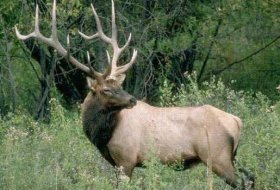 Diet: Wapiti are grazers; that is, they eat mostly grasses, when available. In summer, the diet may be 80 to 90 percent grasses. Bark and twigs of trees and shrubs may contribute half the winter diet. Wapiti sometimes congregate at haystacks in severe weather.
Diet: Wapiti are grazers; that is, they eat mostly grasses, when available. In summer, the diet may be 80 to 90 percent grasses. Bark and twigs of trees and shrubs may contribute half the winter diet. Wapiti sometimes congregate at haystacks in severe weather.
Reproduction: Mating is over by mid-October. Usually a single, obscurely spotted calf is born in May or June, after a gestation period of 8 1/2 months. Females breed first at 3 years of age, males about four. Hunters harvest 40, 000 to 50, 000 wapiti in Colorado each year, the largest number of any state. In the fall rut, bulls spar for dominance and possession of harems of several cows.
Feeding Can Do More Harm Than Good
It is illegal in Colorado to intentionally place or distribute feed, salt blocks or other attractants for big-game animals. This problem is mainly associated with deer.
In the winter, deer herds tend to move to lower elevations closer to homes and businesses. Some people may feel the deer do not have adequate food sources in the wintertime and believe that supplementing their diets with grain, corn or hay is helpful. In fact, the contrary is true.
“People who feed deer do more harm than good, ” said Trina Lynch, a district wildlife manager with the Colorado Division of Wildlife.
According to Lynch, there are several reasons why a Colorado law passed in 1992 makes it illegal to feed big game animals. One important reason is that deer are the primary prey of mountain lions. “Concentrating deer by feeding can attract mountain lions well within the city limits. It may become necessary to kill these lions for public safety, ” she said.
The normal feeding behavior of big game animals allows them to spread out as they graze or browse. Artificial feeding disrupts that behavior and prompts deer to crowd together in small areas where they are more likely to be chased by dogs and hit by cars.
Deer have a complex digestive system that is not adapted to digest bread and many types of hay. Concentrating deer by putting food out can also increase stress on the deer and hasten the spread of disease. Although commercial feeds are available at many stores, Division of Wildlife biologists warn against using them.
People who attract deer to their neighborhood also run the risk of damaging their property and their neighbor’s property. Barriers, repellents and landscaping with native plants are effective in preventing deer from causing damage to lawn and garden projects.
The Division of Wildlife launches controlled, emergency feeding of big-game animals only during extremely harsh winters when substantial numbers of animals are threatened. In all other cases, big-game animals are better off left to obtain their food naturally.
You might also like

